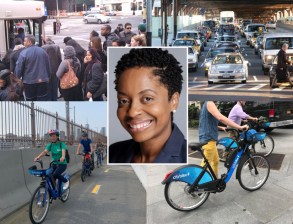Council Transportation Chair Says She Does Want Bike Lanes — But Also Community Board Input

Unelected community boards should be able to dictate the terms of street safety redesigns in their districts — even if that goes against the judgment of city planners, City Council Transportation Chair Selvena Brooks-Powers said this week.
“There’s a narrative being said that communities don’t want bike lanes or communities don’t want bus lanes — but communities want to have input on where these assets are going,” said Brooks-Powers (D-Far Rockaway) during a wide-ranging interview on The City’s “FAQ NYC” podcast in which she said she “acknowledges” the need for more bike lanes, but was “listening to both sides” of a proposal to speed up their installation.
“When we think about addressing an issue in terms of street safety for cyclists, we all share that as a common goal. I think we have a different path to it,” Brooks-Powers told reporter and host Katie Honan.
“The reality is, we need more bike infrastructure — because we’ve acknowledged that there’s an increase in people using bikes to get around New York City. But at the same time, DOT has an awful reputation in communities in how they do their community engagement,” she said.
“There’s input that they want to give — and then you have someone who is making this determination from downtown.”
By “input,” however, the eastern Queens rep appeared to mean that DOT should obey the will of local community boards — whose appointed members tend to be whiter, older, wealthier, and more car-oriented than the populations they serve.
"We went to Staten Island, we talked about the ferry. And I learned they had a train. Fun fact, I did not know they had a train there."https://t.co/JdBlfpccoE
— David J. Meyer (@dahvnyc) April 26, 2023
Brooks-Powers cited as an example DOT’s traffic-calming redesign of Seagirt Boulevard, a dangerous speedway in her district, in which the city narrowed the amount of space for cars with parking-protected bike lanes along both curbs [PDF]. She claimed the existence of a boardwalk adjacent to Seagirt Boulevard negated the need for bike lanes and, somewhat contradictorily, that DOT should have put the lanes along the median.
“I even almost got in an accident at night time because there’s no signage there,” said Brooks-Powers, whose family car once received 17 speed camera violations in a single year.
“I get videos often from people who live along Seagirt of people almost getting into accidents. It’s a matter of time before one happens. At the same time, there’s a bike lane parallel on the boardwalk, which is right there — and so the community is like, ‘Wouldn’t it be better to put it somewhere else as opposed to, right here, or maybe along the median?’”

Reached for comment, a rep for DOT said the agency has done road diets like the one on Seagirt Boulevard in neighborhoods all over the city with measurable safety benefits including a 30-percent reduction in traffic deaths and injuries.
The boardwalk, meanwhile, only allows biking at certain hours, the spokesman noted.
DOT declined further comment, but the agency has backed Council Member Lincoln Restler’s bill, Intro. 417, which would change city law so that the DOT would no longer need to give community boards 90 days notice and then wait 45 days after a community board hearing to install new bike lanes.
The agency is tasked by city law to build 50 miles of new protected bike lanes each year — something the existing requirements make more difficult, Transportation Commissioner Ydanis Rodriguez told Brooks-Powers’s committee during a hearing on Monday.
“Because of the work that we have got to do during the spring, the fall and the summer, by reducing this [wait] time, the bill will help the agency and the whole city to be in a better place to get the numbers of bike lane that we need in our in our city,” Rodriguez testified.
Brooks-Powers’s committee lagged behind nearly all of its peers in terms of legislation passed and hearings held last year, Streetsblog previously reported.
The committee held just three hearings on legislation in 2022. Brooks-Powers has held more than double that in 2023, but pieces of legislation with majority support among Council members continue to languish.
One such bill — Intro. 501, which would allow citizens to report blocked bike lanes, bus lanes, sidewalks and fire hydrants — finally got a hearing on Monday, but Brooks-Powers told Honan she remains opposed even after the legislation was watered down to omit a proposed 25 percent “bounty” for citizen complainants.
“One of my neighbors, well she moved now, she was a traffic agent in the 90s. I used to hear horror stories all the time,” she said, suggesting the “first” solution should be more enforcement by NYPD and expanded use of automated enforcement cameras.
“First thing is first, we need to hold NYPD accountable,” she said. “They need to do their jobs.”



